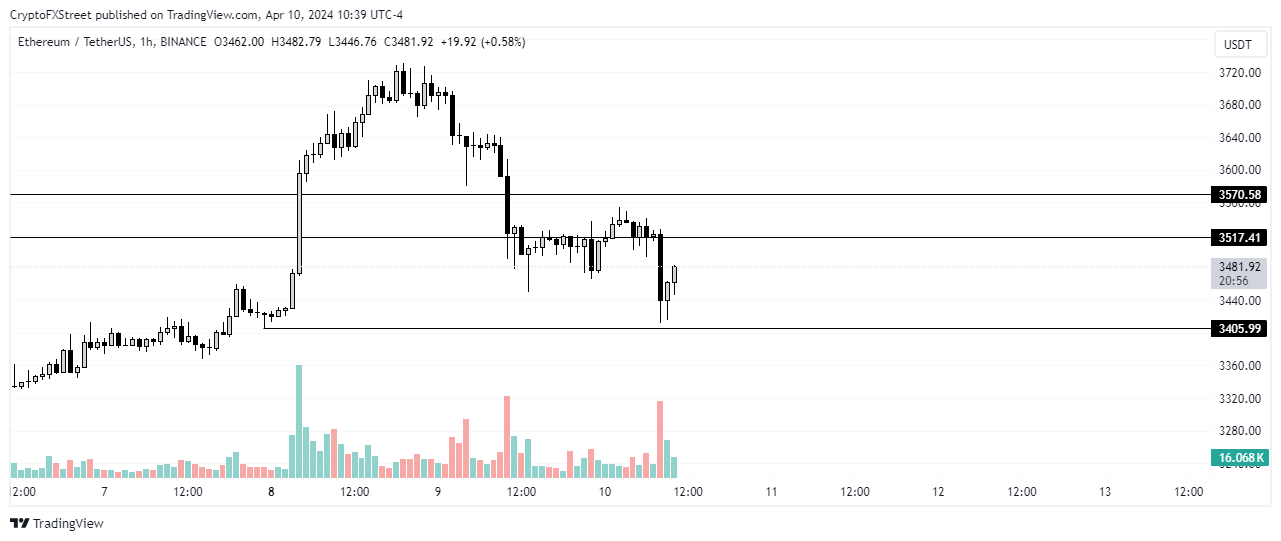- Van Eck’s CEO says Ethereum ETFs are less likely to be approved in May because the SEC has remained silent.
- Following the crypto market correction, Ethereum is down 3.8% as ETH’s long liquidations have topped Bitcoin’s.
- EigenLayer’s launch on Ethereum Mainnet could add momentum to DeFi’s liquid restaking boom.
Ethereum (ETH) is expected to see a price increase in the coming weeks, considering the upcoming Bitcoin (BTC) halving and a potential spot ETH approval. However, on Tuesday, Jan Van Eck, CEO of investment firm Van Eck, stated that the Securities & Exchange Commission’s (SEC) silence already indicates a negative outcome as the May 23 deadline for a decision approaches.
Daily digest market movers: Ethereum ETF approval, low transaction fees, restaking boom
In the wake of a rally that saw ETH tagging $3,730, a general market correction has forced the largest altcoin back to a previous consolidation range formed in March. Here are the recent ETH market movers:
- Jan Van Eck, CEO of investment firm Van Eck, has said that the SEC’s approval of a spot Ethereum ETF by the May deadline is unlikely as the regulator has yet to respond to filings. “We’ve filed our S1, and we haven’t heard anything. So that’s kind of a sign. It won’t happen without getting the disclosure documents in order,” he said to CoinDesk. The SEC faces a May 23 deadline to decide whether or not to approve Van Eck’s spot Ethereum ETF filing.
Unlike Bitcoin ETF applications, which the SEC commented on and engaged institutions about before approval in January, the SEC hasn’t commented on Ethereum ETF filings. As a result, other analysts like Bloomberg’s Eric Balchunas and James Seyffart have also expressed similar sentiments to Jan’s, lowering their odds of an ETH ETF approval in May to 25%. However, Grayscale’s chief legal officer, Craig Salm, has previously stated that silence from the SEC doesn’t hurt Ethereum’s chances of approval.
Also read: Ethereum’s price recovery looks imminent as ETF approval sees a glimmer hope
- While Ethereum ETFs have grabbed most of the headlines, Jan told CoinDesk that reduced transaction costs via Layer 2s and the Solana network is the most important story in crypto that people don’t often talk about. He mentioned how these networks can scale, improve adoption, and keep costs predictable. Ethereum Layer 2s have enjoyed low fees since the Dencun upgrade on March 13.
- Following Jan’s comment, restaking protocol, EigenLayer went live on the Ethereum Mainnet on Tuesday after accumulating $13.56 billion in total value locked (TVL) since its launch. With its Mainnet launch, Ethereum may experience increased restaking activity in addition to the boom of liquid restaking tokens already making waves on its blockchain. EigenLayer also launched the EigenDA, an actively validated service that aims to address Ethereum’s data availability problems by “ushering in an era of cost-effective scalability.”
Technical analysis: Ethereum could test the $3,406 support
Ethereum’s price resumed a consolidating move on Wednesday after a bearish move that saw it shed nearly 4% of its value in the past 24 hours. The move indicates liquidity is still being collected after the bullish spike on Monday.
While Ethereum’s price movement mimics that of the general crypto market – as many altcoins have also been consolidating – its long traders have been affected the most by the market correction. ETH long liquidations crossed $60 million on Wednesday, higher than that of Bitcoin long traders despite lesser volume, according to data from Coinglass. As a result, long traders may exercise more caution while leaving room for bears to prevail.

ETH/USDT 1-hour chart
If this happens, ETH will likely break the $3,406 support. At the time of writing, Ethereum is trading at $3,483.
Bitcoin, altcoins, stablecoins FAQs
Bitcoin is the largest cryptocurrency by market capitalization, a virtual currency designed to serve as money. This form of payment cannot be controlled by any one person, group, or entity, which eliminates the need for third-party participation during financial transactions.
Altcoins are any cryptocurrency apart from Bitcoin, but some also regard Ethereum as a non-altcoin because it is from these two cryptocurrencies that forking happens. If this is true, then Litecoin is the first altcoin, forked from the Bitcoin protocol and, therefore, an “improved” version of it.
Stablecoins are cryptocurrencies designed to have a stable price, with their value backed by a reserve of the asset it represents. To achieve this, the value of any one stablecoin is pegged to a commodity or financial instrument, such as the US Dollar (USD), with its supply regulated by an algorithm or demand. The main goal of stablecoins is to provide an on/off-ramp for investors willing to trade and invest in cryptocurrencies. Stablecoins also allow investors to store value since cryptocurrencies, in general, are subject to volatility.
Bitcoin dominance is the ratio of Bitcoin’s market capitalization to the total market capitalization of all cryptocurrencies combined. It provides a clear picture of Bitcoin’s interest among investors. A high BTC dominance typically happens before and during a bull run, in which investors resort to investing in relatively stable and high market capitalization cryptocurrency like Bitcoin. A drop in BTC dominance usually means that investors are moving their capital and/or profits to altcoins in a quest for higher returns, which usually triggers an explosion of altcoin rallies.

























